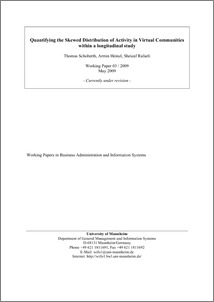|
Quantifying the skewed distribution of activity in virtual communities within a longitudinal study
Schoberth, Thomas
;
Heinzl, Armin
;
Rafaeli, Sheizaf
![[img]](https://madoc.bib.uni-mannheim.de/style/images/fileicons/application_pdf.png)  Vorschau |
|
PDF
Working_Paper_3_2009.pdf
- Veröffentlichte Version
Download (703kB)
|
|
URL:
|
https://ub-madoc.bib.uni-mannheim.de/2368
|
|
URN:
|
urn:nbn:de:bsz:180-madoc-23686
|
|
Dokumenttyp:
|
Arbeitspapier
|
|
Erscheinungsjahr:
|
2009
|
|
Titel einer Zeitschrift oder einer Reihe:
|
None
|
|
Sprache der Veröffentlichung:
|
Englisch
|
|
Einrichtung:
|
Fakultät für Betriebswirtschaftslehre > Sonstige - Fakultät für Betriebswirtschaftslehre
|
|
MADOC-Schriftenreihe:
|
Area Information Systems and Institute for Enterprise Systems > Working Papers Lehrstuhl für ABWL und Wirtschaftsinformatik (Heinzl) (bis 2011)
|
|
Fachgebiet:
|
300 Sozialwissenschaften, Soziologie, Anthropologie
|
|
Normierte Schlagwörter (SWD):
|
Virtuelle Gemeinschaft , Soziales Netzwerk , studiVZ , MySpace
|
|
Freie Schlagwörter (Englisch):
|
virtual communities , social network analysis , communication activity , heterogeneity , preferential binding , uniform binding , random graph theory
|
|
Abstract:
|
Virtual Communities (ViCs) are subject of interest for quite some time now [Hagel and Armstrong, 1997, Garton, et al., 1997, Rheingold, 1993]. Recently, ViCs in the form of Social Network Services like MySpace or StudiVz received a lot of attention. Though, fairly little is known about the temporal evolution of virtual communities and the changes in the communication activity of its users. The research described here is an explorative study examining the communication activity of members of two virtual communities on a longitudinal basis. For that purpose, a graph theoretical model by Pennock et al. [2002] is used which unites “Random Network Theory” and “Scale-free Networks”. This model allows the operationalization of the empirical distribution functions of the communication activity in ViCs with only one free parameter. That parameter – the mixing factor α – represents the ratio between the antagonists heterogeneity and homogeneity. The nonlinear curve fitting of the empirical distribution functions shows a predominance of preferential over uniform binding in both communities. Participants prefer to communicate with community members having already a lot of communication partners, while members with low activity are less attractive. This phenomenon is less strong in the smaller ViC B. The members of ViC B have almost twice as many connections as those of ViC A. ViC B represent a tighter network which might lead to the more homogeneous distribution of its activity. In both communities the mixing factor α and therefore the level of heterogeneity shows quite stable over time.
|
 | Das Dokument wird vom Publikationsserver der Universitätsbibliothek Mannheim bereitgestellt. |
 Suche Autoren in Suche Autoren in
Sie haben einen Fehler gefunden? Teilen Sie uns Ihren Korrekturwunsch bitte hier mit: E-Mail
Actions (login required)
 |
Eintrag anzeigen |
|
|



 Suche Autoren in
Suche Autoren in